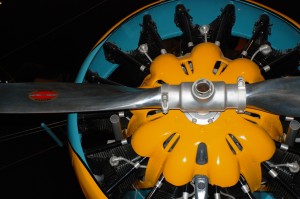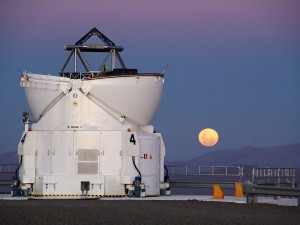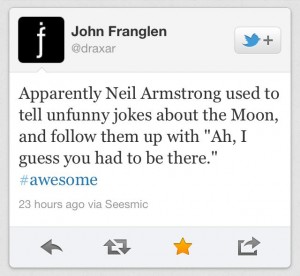I don’t know if I mentioned it, but I just moved from Indiana to New Jersey for work. On the way east, we stopped at the National Museum of the Air Force in Dayton, Ohio. I have lots to say about it and no time to say it (did I mention I just started a new job?), but I finally managed to post a few passable photos out of the collection for your enjoyment. I thought the Museum of Flight was a challenge to photograph, but the Dayton museum made taking photos in Seattle look like a cake walk. I promise promise I will come back and talk about curatorial narratives, the arrival of the Space Shuttle trainer, and much more as soon as I get these article revisions out the door.
National Museum of the Air Force
12 09 2012Comments : Comments Off on National Museum of the Air Force
Categories : Museums, Planes, Tourism
Wallpaper Wednesday
12 09 2012Today’s wallpaper is apropos of nothing in my life right now. Rather, it’s a beautiful image of the night sky above Helmos Observatory, home to the 2.3 meter telescope ARISTARCHOS. Helmos might be placed in one of the most beautiful parts of the world (if you don’t believe me, check out the observatory’s image gallery).
Click on the image to go to the appropriate National Geographic wallpaper download page.
Comments : Comments Off on Wallpaper Wednesday
Categories : Instruments, Observatories, Wallpaper
Robert A. Schommer Astronomical Observatory
5 09 2012The public viewing schedule through February 2013 at the Robert A. Schommer Astronomical Observatory at Rutgers is available online. I’ll be making my first night visit on September 12 (weather permitting), so look for a post about the history of the observatory and its instruments in the next couple of weeks.
Comments : Comments Off on Robert A. Schommer Astronomical Observatory
Categories : Observatories
Wallpaper Wednesday
5 09 2012Today NASA announced that Dawn has escaped the asteroid Vesta’s gravitational pull. The spacecraft is now “officially” on its way to Ceres, the first dwarf planet detected by humans. Stop by the mission website to watch Dawn’s Greatest Hits, a splashy video highlighting the research accomplishments at Vesta, the most interesting of which were a series of discoveries that led to the conclusion that Vesta resembled a minor planet more than an asteroid. Dawn’s work at Ceres will be exciting: what started out as a comparison between an asteroid and a dwarf planet has turned into a comparison between two different types of small planets. Check out When is an Asteroid not an Asteroid? for more on that story.
Dawn’s Greatest Hits:
Farewell Portrait of Giant Asteroid Vesta:
Click on the image at the top of the post to download the wallpaper.
Comments : Comments Off on Wallpaper Wednesday
Categories : Instruments, NASA, News, Wallpaper
MSL Windows Theme
30 08 2012If you are using a Windows machine, you can now download a theme for your computer featuring Mars Science Laboratory Curiosity images, courtesy of Windows Observer.com. I don’t usually use themes because I’m too obsessed with my own wallpaper choices, but in this case, I’ll make an exception.
Comments : Comments Off on MSL Windows Theme
Categories : Mars Science Laboratory
Astronomy Photographer of the Year
30 08 2012In case you missed it, the Royal Museums Greenwich has announced its list of finalists for Astronomy Photographer of the Year 2012. Space.com has a nice gallery of the finalists, but you can see the entire competition pool on flickr. You might want to settle in for a long session in front of the computer, though, because the group includes almost 9,000 photos. On one hand, awesome. On the other hand, those poor judges.
Of the finalists, I’m a fan of Sunny Airlines by Dunja Zupanic. I haven’t made it through all 8,756 photos in the general pool, but I like Toby Harriman’s photo of the aurora borealis taken at Sparks Lake, Oregon, among others.
Comments : Comments Off on Astronomy Photographer of the Year
Categories : News
Roger Hayward’s Moon (Griffith Observatory)
29 08 2012As I was sifting through images of the moon this morning, I found this photo taken at Griffith Observatory in 1939. Shown is Roger Hayward, the artist commissioned in 1934 to create a model of a section of the moon for the observatory. Hayward was trained as an architect, earning his degree from MIT before relocating to Pasadena to pursue a career as a designer. He served as chief designer for the Los Angeles Stock Exchange (1929), designed by his MIT classmate, Sam Lunden, and also contributed to Lunden’s design for the Doheny Library at USC (1930). If you recognize his name, however, I doubt it’s because you’ve been studying his architectural designs. It’s more likely you remember the illustrations he did for the “Amateur Scientist” column in Scientific American magazine between 1949 and 1974, or even more likely, the drawings he did to illustrate Linus Pauling’s research.
How does one make the leap from architect to illustrator of science? In Hayward’s case, it involved a brief stop at the moon. Moving to Pasadena worked out well for him, even though the Great Depression shut down his career as an architect almost as soon as it had begun. When the Stock Market crash put an end to large-scale design projects in southern California, Hayward kept himself busy with painting, puppetry, and physics. Pasadena sits just below Mount Wilson, so when Hayward’s interests expanded to include astronomy and mathematics, he was able to take advantage of the Caltech minds at work at the Mount Wilson Observatory. Various Caltech associates tutored him in atomic theory and he built a few smaller instruments—a 6-inch reflector telescope, a quartz spectograph—by way of educating himself in the field.
The various strands of his formal and self-education came together in 1934, when the Griffith Observatory and Planetarium commissioned him to design “the world’s largest” model of a section of the moon (more images here). As reported in The Literary Digest the next year,
“Most spectacular of the exhibits [at Griffith Observatory and Planetarium] will be in the south gallery—a thirty-eight-foot plaster model of the moon, made to scale from Mt. Wilson Observatory photographs by Roger Hayward, of Los Angeles, an architect by profession and an astronomer by preference, and Caspar Gruenfeld, a sculptor. It will be illuminated by moving lights to produce the effect of sunlight.”[1]
Hayward was given access to the 100-inch telescope on Mount Wilson so he could supplement the observatory’s photographs with first-hand observation of the moon. His design (and Gruenfeld’s sculpting work, Gruenfeld is always left out of the story) was apparently well-received, as the observatory commissioned him to design and build models of Oregon’s Crater Lake and Arizona’s Meteor Crater as soon as he finished the moon section.[2] Adler Planetarium was eager to get in on the action and hired Hayward to design a scale moon model with a 6-foot diameter. Walt Disney eventually saw the financial potential in the projects and commissioned Hayward to duplicate his moons for the “Man in Space” television show and Tomorrowland exhibits.
Although he worked in other fields after finishing the models (he designed a commercial nutcracker, for god’s sake), Hayward continued to advance his studies in astronomy and physics. He partnered with a Caltech associate to design a movie projection screen and write a physics textbook. He must have thought he’d died and gone to heaven when he was offered a position as an optical engineer at Mount Wilson Observatory in 1941. Much top secret stuff in support of the war effort ensued.
After the conclusion of the war, Hayward partnered with Sam Lunden once again, forming the firm of Lunden, Hayward & O’Connor. For architectural historians, Hayward’s story tends to end here: the firm designed the Los Angeles City Health Building, the Mira Costa High School, a VA hospital in Arizona, the Temple Israel of Hollywood, and several other mid- to high-profile projects in the LA basin. However, although the partnership looked successful from the outside, from the inside, it was obvious that it was flawed almost as soon as the papers were signed by the trio. Hayward and O’Connor in particular didn’t get along and the partnership was dissolved in 1957.[2]
The tension between Hayward and O’Connor probably had something to do with the fact that Hayward’s attention was always directed elsewhere. Specifically, he was more concerned with his delineating work for Scientific American than he was with the success of Lunden, Hayward & O’Connor. He had completed his first job for the magazine in 1948, illustrating George Beadle’s “The Genes of Men and Molds”. The quality of Hayward’s drawings pleased the magazine, the paycheck pleased Hayward. Although he worked on many projects throughout the rest of his career—collaborating with Linus Pauling, for instance—Hayward continued to draw for Scientific American until his health and vision failed him.
The burning question of the day: what happened to the lunar section Hayward and Gruenfeld built at Griffith Observatory? Many (mistaken) bloggers attribute the moon currently on display at the observatory to the hand of Hayward, but that’s a much more recently produced object and at any rate, not a section model, but a smallish moon (there’s no way Hayward could perch on top of it and sculpt the Mare Imbrium region). According to a comment that appears to have been written by someone associated with Griffith Observatory, the Crater Lake and Meteor Crater models are in storage.[3] But where’s the lunar section? Contacting the observatory is on my list of things to do, but in two days, I’m moving halfway across the country, so that list is going to have to wait awhile. If you know, drop me an e-mail and I’ll update this with the information.
ETA: Here’s a link to a few construction photos of Griffith Observatory and Planetarium. You’re welcome.
———————
Most of the information included here about Roger Hayward comes from on material held in the Special Collections & Archives Research Center, Oregon State University Libraries. See Roger Hayward: Renaissance Man for a glimpse into the archive.
[1] “An Observatory for the Public,” The Literary Digest (April 20, 1935): 28.
[2] Ben H. O’Connor, “Letter from Ben H. O’Connor to Samuel E. Lunden and Roger Hayward, 1957,” in Special Collections, Item #2356, (accessed August 29, 2012).
[3] See “Comment on Kevin Kidney: Mr. Hayward’s Moon Model.”
Comments : Comments Off on Roger Hayward’s Moon (Griffith Observatory)
Categories : Ephemera, Griffith Observatory, Instruments, Observatories
Wallpaper Wednesday
29 08 2012Today’s wallpaper features a couple of my favorite things: the Paranal Observatory and a full moon. Gianluca Lombardi took this photo of one of the Auxiliary Telescopes (AT) at Paranal, using the colors of the sunset to their best advantage. Visit the ESO website to read more about light scattering, the red moon effect, and the role of the AT in the VLT Interferometer (VLTI).
Click on the image above to download the wallpaper or the original photo (download links will be in the page’s right sidebar).
Comments : Comments Off on Wallpaper Wednesday
Categories : Observatories, Wallpaper
Neil was wrong
27 08 2012I was out enjoying Mammoth Cave National Park when the news of Neil Armstrong’s death broke this weekend. By the time we wandered back into 3G range, my fb and twitter feeds were dense with links, photographs, re-posts, and memorials.
My first reaction was on the petty side of life. When my partner asked how old Armstrong was (82), I instantly calculated how many years longer he had lived than my dad. After that, I calculated how much longer he had lived than my closest friend’s dad. I’ve been told this “how unfair is it that this guy lived so much longer than my dead parent?” reaction is typical, but I guess “typical” and “astronaut” aren’t two words that should occur in the same sentence.
My second reaction was to consider how members of different generations would respond to the news. In terms of age, I represent the big break—my earliest memory is of the first lunar landing, or more properly, watching the news broadcast from my dad’s lap. Americans older than I am are likely to have their own memories of Apollo 11, but people younger than I am will experience those memories as reflections, directed toward them by their parents or older siblings, books or movies.
My third reaction was to wonder how my students would react to the news. As I’ve mentioned before, the majority of them believe the lunar landing was a hoax. If the first man to walk on the moon dies, but you believe he’s been lying for past twenty-five years, are you going to roll your eyes? Or are you going to take another look at the evidence and perhaps re-evaluate your position?
As I was hiking from Echo River Spring up to Mammoth Dome Sink on Sunday morning, I tried to decide if any of these reactions was blog-worthy (no). Did I even need to write about Neil Armstrong’s death? By the time I got back to the Internet, Google was returning 3875 news articles on the subject. 95% of my fb friends had written about it. Twitter was a long, repetitive scroll of re-tweets. I didn’t think there was much more to be said about it, really.
But then I heard Neil deGrasse Tyson on NPR this morning, sharing his memory of meeting Neil Armstrong in 1973 (Armstrong was “very friendly…very warm”). What caught my attention was the following exchange:
TYSON: But I think, for me, what matters there, is he’s an American icon because he embodied all of our dreams of what it is to explore. And since we haven’t been back to the moon in 40 years, for me, part of me died with him, because the dream hasn’t been sustained. And that worries me, greatly, about the future of us as a space-faring nation.
INSKEEP: Was his accomplishment, then, a dead end?
TYSON: It has been, and if we’re not back out of low Earth orbit for another 20 years, it makes me wonder whether it’ll ever happen again. So it’s a sad moment, because the future did not become real for his achievement.
I know it’s bad form to contradict Neil deGrasse Tyson, but…here goes.
Tyson seems to be arguing that the purpose of the Apollo program was to cultivate future manned space programs. Manned space exploration didn’t flourish after Apollo; therefore, the American dream of space exploration has failed and we haven’t reached the “real” future. But surely the gathering of knowledge about the universe is not a linear or predictable process. There must have been hundreds—thousands—of possible trajectories for the development of science programs and knowledge-gathering missions after Apollo. We’ve followed some of those trajectories to their farthest points, developed some astonishing unmanned spacecraft and released them into the wild, and yet we’ve failed because we haven’t sent a human back to the moon or beyond a low-orbit space station.
What is the purpose of space exploration? Is it to move human bodies from here to there? Is it about commercial exploitation of off-planet resources? Is it to answer questions about where we come from or where we’re going? Opinions vary, obviously, but as a scholar, my greatest motivator is a desire to know, not a desire to go. Maybe there are parts of the universe that can only be understood if experienced in person, but there are at least as many that don’t require our presence in order to study them. We can study them by proxy with unmanned spacecraft. For instance,
- Explorer 1: detected the Van Allen Radiation Belts
- Mariner 2: infrared and microwave measurements of Venus
- Ranger 7: first close-up photographs of the Moon
- Pioneer 10: first spacecraft to cross the asteroid belt, first close-up photos of Jupiter, transmitted data for 30 years
- Voyagers 1 and 2: holy cow, almost to interstellar space 35 years after launch
- Galileo: orbiter and atmospheric probe of Jupiter (eruptions on Io, one of Jupiter’s moons)
- Mars Global Surveyor: involved the public in the selection of survey sites
- Mars Pathfinder: camera plus Sojourner, we are roving on Mars
- Stardust: collected particles from Comet Wild 2 and returned them to Earth!
- Hubble Telescope: there’s not enough room to tell you everything
- MSL Curiosity: OMG….
I’m not trying to downplay the accomplishments of Neil Armstrong or any other astronaut. I understand that Tyson is paying homage to one of the most courageous people to walk the earth, not to mention the moon. At the same time, I think Tyson is restricting us to a very limited definition of “explore.” The things we’ve learned through unmanned space exploration aren’t negligible and as MSL Curiosity has demonstrated, we haven’t lost our desire to reach new worlds. We’re just using a different tool set to make that happen. I think that’s a very astronaut thing to do—if one approach doesn’t work, we’ll try another. That’s how Neil Armstrong got to the moon and how Curiosity got to Mars.
We can mourn the death of Neil Armstrong, but I think the lament for the American dream of exploration is a bit premature.
Comments : Comments Off on Neil was wrong
Categories : News
Lowell Observatory
24 08 2012Pop over to Space.com to take a gander at their photos of Lowell Observatory.
Comments : Comments Off on Lowell Observatory
Categories : Observatories






